Every night could be the aurora night. Don't Miss Out
If you're traveling to Iceland, you've likely heard about the Golden Circle Iceland Route - a must-do for travelers who want to truly experience the Land of Ice and Fire.
In this ultimate guide, we'll help you navigate Iceland’s top Golden Circle attractions and hidden gems, from what to expect to insider tips for planning your itinerary.
The Golden Circle is a world-famous tourist route in South Iceland. It is named for its circular shape on the map, which makes it easy to drive. It is also sometimes called ‘the golden ring’ or the ‘golden road.’
The name "Golden Circle," or "Gullni hringurinn", is a promotional term inspired by the Icelandic name for one of its key attractions, Gullfoss, which translates to "golden waterfall."
The journey begins in the capital city of Reykjavík and takes you inland to explore some of Iceland's most remarkable natural and cultural attractions. It covers approximately 149 miles (240 kilometers) if you follow the loop or 190 miles (300 kilometers) if you include the detours.
So, what can you see on this famous Golden Loop? The standard road trip will take you to the three iconic landmarks:
Part of what makes this route so wonderful is that besides the main Golden Circle attractions, numerous additional locations are waiting to be discovered.
As you drive, you'll also have the chance to stumble upon hidden hot springs, small waterfalls, and serene trails. Some noteworthy detours include the Geothermal Tomato Farm, Fontana Baths, Kerið Volcano Crater, and the Skálholt Cathedral.
Let's start by exploring the three main Golden Circle stops. You'll get to know Iceland's rich history and stunning nature in these locations. While there are other less popular places to explore nearby, the big three are undoubtedly worth your time!
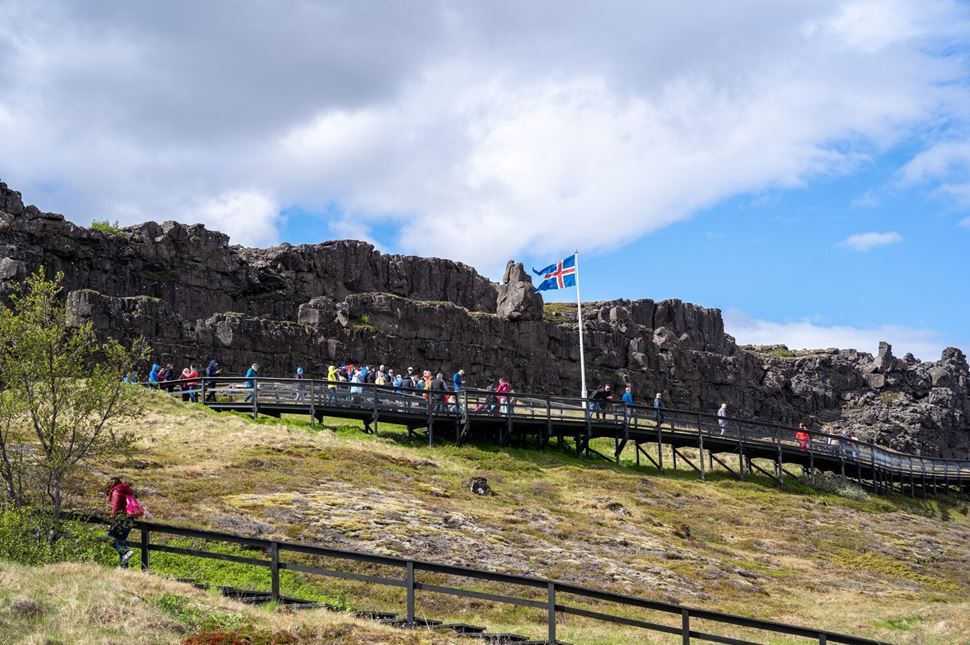
Sightseeing Thingvellir National Park. Source: Arctic Adventures
Thingvellir (Þingvellir), recognized as a UNESCO World Heritage Site, is incredibly important in Icelandic history and culture.
Not only is it a stunning national park, but it's also the birthplace of Iceland's ancient parliament, the Althing, established in the year 930 AD, making it one of the oldest surviving parliaments in the world.
Serving as the meeting place for Iceland's chieftains, Alþingi was the venue for the country's legislative assembly, where laws were passed and disputes were settled.
Geologically, Þingvellir lies in a rift valley, which is formed by the separation of two tectonic plates, the North American and the Eurasian.
The tectonic plates are gradually moving apart due to the spreading of the Mid-Atlantic Ridge, which runs through Iceland.
As a result, the landscape formed dramatic cliffs and fissures, such as the Almannagjá ravine and Silfra gap, which symbolize the separation between the two continents. Each year, the plates shift about 0.78 inches (2 cm), changing the landscape and making it a unique sight.
Tourists often visit specifically to witness this unique geological phenomenon. You can even go Silfra snorkeling or tectonic plates diving in the purest water on Earth.
Another place you can visit in the park for free is Þingvallavatn Lake, the biggest natural lake in Iceland. It supplies clear water for Silfra Fissure and is a popular spot for fishing.
A very popular attraction in Thingvellir is the waterfall Öxarárfoss, which is especially stunning when its pool freezes in winter and becomes an ice sculpture. The falls are easy to reach, with a short walk from the Visitor Center.
» Drive in 45 min from Reykjavik
» Entrance to the park is free for all
» The parking fee is 1000 ISK (about $7)
» Visit the visitors' center with exhibits and snacks

Water shooting out of the geyser. Source: Arctic Adventures.
Geysers and hot springs are some of Iceland's most amazing features, with over 700 geothermal sites. Geysir Area is a fascinating part of Haukadalur Valley in Southwest Iceland and it is famous for its geothermal activity. Here, you can find two of the most visited geysers: The Great Geysir and Strokkur.
The Great Geysir is known as the king of all geysers, and all others in the world are named after it. The Icelandic word “geysa” means “to gush,” which is where the English word comes from. Geysir is very old and was first mentioned in 1294. Although it is not active now, it used to erupt up to 558 feet (170 meters) high.
Strokkur remains the most active geyser in Iceland. You can watch it erupt every 10 to 15 minutes. This greatest active geyser on site shoots hot water into the sky, reaching heights of 49-66 feet (15 to 20 meters).
The geothermal field is not just about geysers, though. You will also see colorful bubbling mud pools, smaller geysers and hot springs, and steam vents (fumaroles).
The ground around the hot springs throughout shows vibrant colors from minerals: green from copper, red from iron, and yellow from sulfur. This also gives the place a distinctive eggy smell.
» Drive 50 minutes from Thingvellir to Geysir
» Enter for free to the Geysir Geothermal area
» Geysers are a 5-minute walk from the parking lot
» Plan around 1 hour for eruptions and walking

Gullfoss Waterfall. Source: Arctic Adventures
The last official stop on the Golden Circle Route is Gullfoss Falls, also known as the Golden Falls. Located on the Hvítá River, which originates from Langjökull glacier, it is one of Iceland's most famous landmarks.
In the early 1900s, there were plans to turn it into a power plant, but thanks to the efforts of a local farmer's daughter, Sigríður Tómasdóttir, the project was stopped, preserving this pearl of nature.
Gullfoss is a two-tiered waterfall with two cascading levels. The first drop is 36 feet (11 meters), followed by the second drop at 69 feet (21 meters).
The river bends sharply just before it drops into a deep gorge, creating a spectacular waterfall that vanishes into deep space, leaving a stunning mist behind.
During summer, the waterfall flows like a rushing river, while in winter, it's more like a gentle stream.
There are upper and lower viewing platforms at Gullfoss, both with great sights. From the upper deck, you can see a wider panorama of the falls, while the lower one is for a close-up.
❯ Despite the two-rope safety fence, keep a close eye on kids while hiking the Gullfoss trail!
A 1.3-mile (2.1 km) round-trip walking trail to the falls takes 15 to 30 minutes to complete.
» Gullfoss is a 7-minute drive from Geysir
» The waterfall is free to visit
» Plan to spend at least 1 hour at the falls
» Expect windier and colder conditions
» Wear a rain jacket for spray protection
While Gullfoss is the most dramatic, there are also three smaller waterfalls that are well worth a short detour:
This circular sightseeing route is in southwest Iceland, just outside the capital city of Reykjavik. The southwest region is celebrated for its volcanic terrain, geothermal features, and proximity to glaciers like Langjökull.
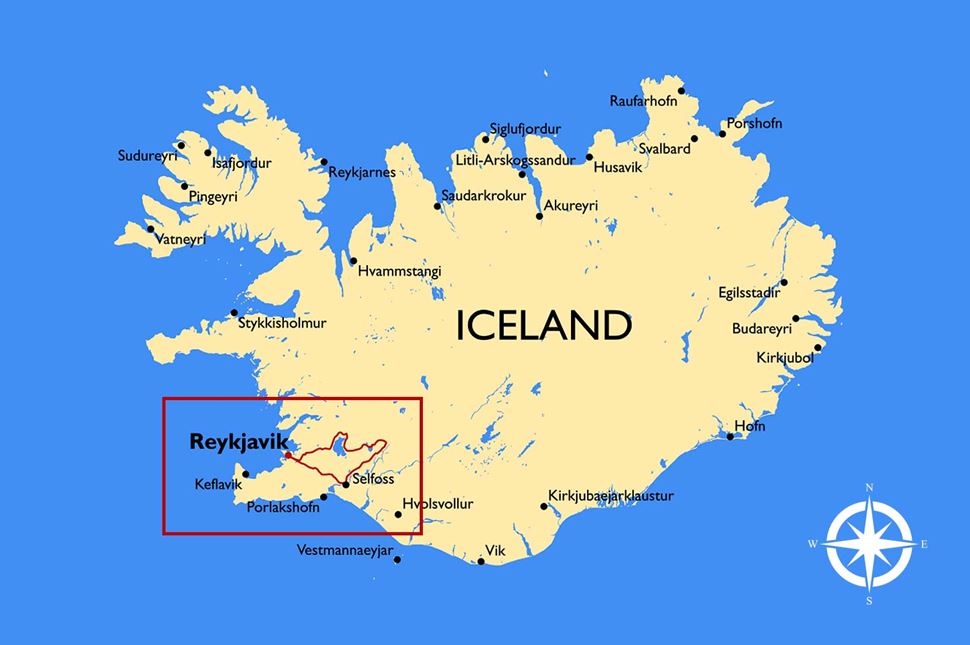
Location of the Golden Circle in Iceland.
To help you navigate through the standard stops of the Þingvellir National Park, Geysir Geothermal Area, and Gullfoss Waterfall, use our detailed Golden Circle Route map and plan your journey!
This iconic itinerary in Iceland offers two options, depending on your budget, desire for flexibility, and other travel arrangements:
Remember that Iceland's winter weather is unpredictable, with snowstorms, icy roads, and reduced daylight, which can be hazardous for driving. A guided tour is a safer and more reliable option when road conditions are difficult.
But in summer, when the weather is better, and roads are easier to drive, you might prefer exploring the Ring independently.
The Golden Ring can be done in one day from Reykjavik, and it is a popular choice. However, if you're traveling with kids, it’s a good idea to stay for a night or two. This way, you'll have plenty of time to enjoy the main stops fully.
Regardless of how you choose to travel, you'll undoubtedly witness Iceland's breathtaking landscapes firsthand!
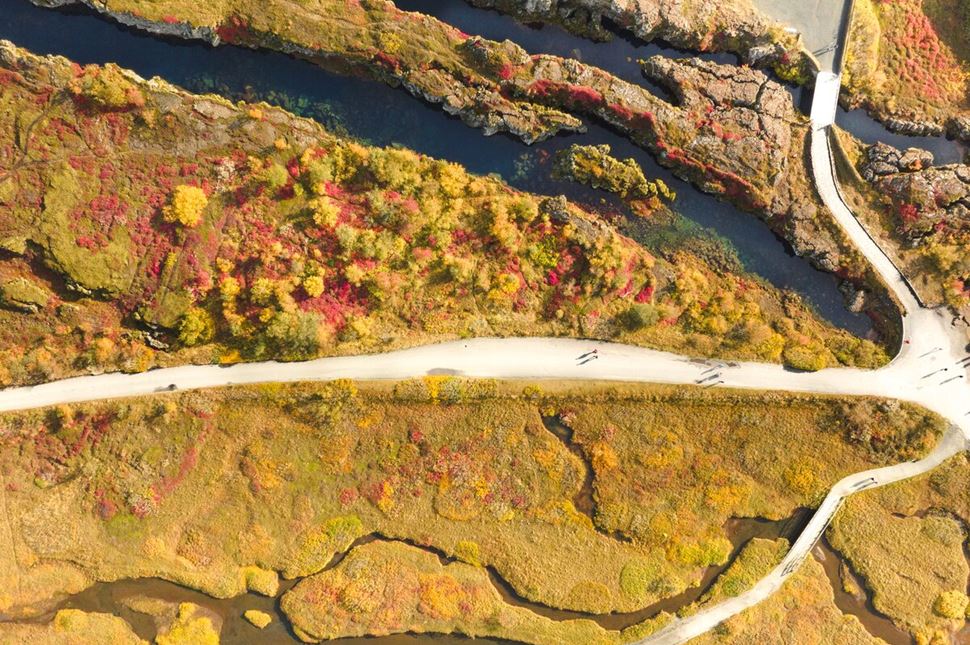
Roads by Thingvellir National Park. Source: Arctic Adventures
Self-driving gives you the freedom to stop wherever and whenever. You can uncover hidden spots that guided tours might skip and spend as much time exploring them as you like.
Car rental costs between $20 and $150 per day, while an SUV can be around $500 per day. The price depends on the type of vehicle and especially the time of year. While a 2WD car is usually sufficient for winter travel or extra stops off the beaten track, a 4WD is recommended for continuing into the highlands.
A cost-saving option is renting a campervan, which provides transportation and accommodation.
❯ To avoid the crowds, start your sightseeing early in the morning. You can even travel under the midnight sun in the summer as the nights don't get dark.
As mentioned above, self-driving in winter poses risks due to Iceland's unpredictable winter weather, including icy roads and limited daylight.
In general, this iconic 140-mile (230-kilometer) loop can be completed in about 3 hours if you take the shortest route. However, with stops to enjoy the attractions, take photos, and refuel, the journey typically extends to 5-6 hours.
If you prolong your Golden Circle driving time to 8 hours, you can add a relaxing soak at the Secret Lagoon, while 9 hours or more allows for visits to places like the volcanic crater lake Kerið or the town of Hveragerði for a deeper exploration of Icelandic landscapes.
❯ Be sure to keep your vehicle’s door closed. The wind speed in Iceland can reach up to 40 mph (64 km/h) - strong enough to tear a car door off if left open and unattended even for a split second.
Assess the wind speed forecast to know what to expect. Prepare thoroughly for your trip with this Golden Circle driving guide and Iceland Golden Circle day itinerary.
If you prefer another alternative, like guided excursions, you can book one of the many Golden Circle Tours available here.
Our guides bring valuable local knowledge, expertly manage challenging roads, and offer captivating insights. They're also equipped with emergency plans tailored for remote areas.
Choosing a tour ensures you can fully immerse yourself in the adventure without the anxiety of facing Iceland’s driving challenges alone.
A guided tour of the Golden Circle typically lasts about 8 hours. It covers “the Big 3” standard stops, with an additional visit to the Kerid volcanic crater and possibly Hveragerdi town.
Tours extending to 10-12 hours include extra activities like snorkeling, a snowmobile Golden Circle tour, or a visit to the Blue Lagoon.
This gives you additional time for a more extensive discovery of Iceland's natural wonders and often provides opportunities for adventures beyond the core Golden Circle attractions.
If you have a full day for sightseeing, why not add a few extra detours to your itinerary? While Þingvellir, Geysir, and Gullfoss are the biggest highlights, there are plenty of other exciting spots to consider.
These stops, often included in many itineraries of the loop, are strategically placed between the main locations and on the return trip to Reykjavik, allowing you to visit and see more of Iceland's beautiful scenery in one go.
Here are five additional unique Golden Circle highlights you won't want to miss:
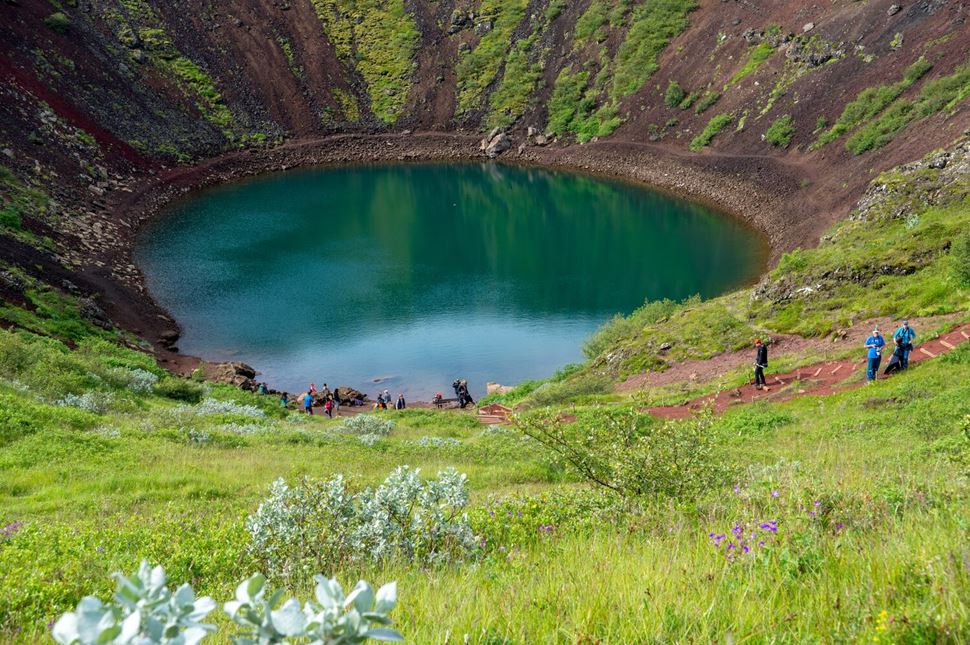
Kerið volcanic crater lake. Source: Arctic Adventures
This 6,5000-year-old volcanic crater lake is located in the Grímsnes area in South Iceland. It is so impressive and close to the main route that it is often included as one of the main highlights.
Kerid Crater (Kerið) is a unique geological formation with bright red crater walls and a gorgeous blue lake in the middle. It looks like a regular hill from afar, but it’s impressively enormous once you approach it!
The crater is open during daylight hours, with varying opening times based on the season: from 8:00 to 21:00 in summer and from 10:00 to 17:00 in winter. There is free parking on a gravel lot nearby, allowing you to drive up close and easily walk to the crater's edge, making it a convenient and accessible stop on the route.
Entrance to the site is paid. You can get your Kerid admission ticket in advance to skip the queue when you get there.

Laugarvatn Fontana View. Source: Laugarvatn Fontana
Laugarvatn Fontana is a cozy spa located in Iceland’s pretty village of Laugarvatn. If you're coming from Thingvellir National Park, it's about 15.5 miles (25 kilometers) away.
At the spa, you can enjoy saunas, steam rooms, hot tubs, and different pools with warm water. There are even shallow pools for kids. And don't forget to try their special lava bread - it's baked using heat from underground!
Book your ticket to Fontana Baths in advance to enjoy a smooth trip!
Thjorsardalur (Þjórsárdalur) Valley is located on the edge of the Southern Icelandic Highlands and is a beautiful place along Iceland's longest river.
Here, you'll find amazing sights like the powerful Háifoss waterfall, which drops from a height of 400 feet (122 meters). Iceland's longest river, Thjorsa, flows through this valley at 230 kilometers (140 mi), and there is even a mixed forest - a rare sight in Iceland.
The valley is also rich in plant life, with many different flowers, grasses, and mosses. You can visit landmarks like the replica of a Viking-era farm and the Hjálparfoss waterfall.

Cozy Secret Lagoon.
Called ‘Gamla Laugin’ in Icelandic, or the Secret Lagoon, and it feels like a cozy hot tub tucked away in a place where the earth is naturally warm.
It's located in Flúðir, a small town known for its geothermal activity. The lagoon's water stays warm, around 38-40°C (100-104°F) all year round, making it perfect for a swim any time!
Around the pool, you will find small paths to wander along and even a tiny geyser that shoots water up every few minutes.
Skálholt and its Cathedral are great places to visit on your journey, especially if you're interested in Icelandic history. Between 1056 and 1785, Skalholt was considered one of the most important cultural and political centers in Iceland. Even though an earthquake took down the big cathedral, the Evangelical Lutheran church still stands.
The roads along the Golden Circle in Iceland are generally well-maintained throughout the year. However, be aware that natural events can make it temporarily difficult to access the attractions or explore them fully.
If you want to avoid the crowds when visiting the Golden Circle, it's a good idea to plan your trip outside the busiest times, usually from 11 am to 2 pm. During these hours, larger tour buses arrive, making the stops more crowded.
Winter (September-April) has colder temperatures, ranging on average from -1°C to 3°C (30°F to 37°F), with snowfall and icy conditions.
The cold season transforms the Golden Circle into a winter wonderland with frozen waterfalls and snow-covered lava fields.
There is a big advantage - now is the best time to witness the Northern Lights in Iceland, especially from October to March.
However, visiting in winter means dealing with significantly fewer daylight hours, ranging from 4 to 6 hours per day. For example, sunrise can occur as late as 10 am or later, and sunset can be early, limiting your time for exploration.
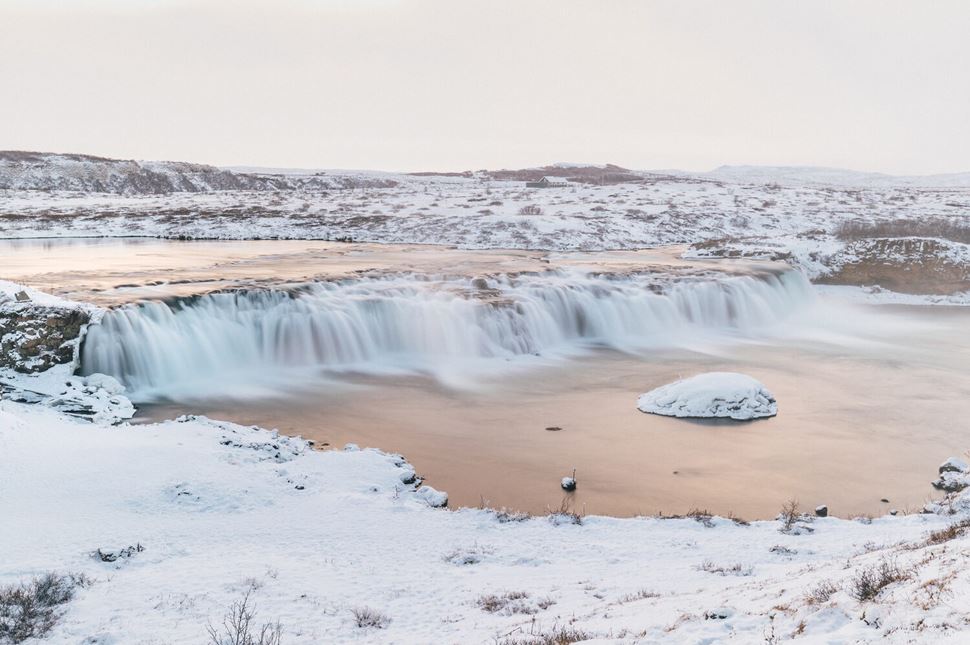
Frozen Faxi Waterfall. Source: Arctic Adventures.
During summer (May-August), Iceland experiences mild temperatures ranging from 9°C to 15°C (48°F to 59°F). This is the peak tourist season, with long daylight hours and nearly 24-hour sunlight in June!
Popular activities during this time, along with Golden Circle sightseeing, include river rafting, horse riding, fishing, and puffin-watching.
A big plus of the summer is the phenomenon of the Midnight Sun. You can adjust your schedule to explore late at night or very early in the morning and still have plenty of daylight.
It's a perfect opportunity to experience Iceland's stunning nature in the soft light of the Arctic summer and capture some amazing photos.
But if you want to visit the beautiful Golden Ring trail in the season with the fewest tourists, you should consider visiting in April and May.
Note: Icelandic weather can affect your trip any time of the year, so always check real-time road conditions and weather forecasts.
Exploring Iceland's landscapes can work up quite an appetite! Here are some of the best places to eat along the way. Here, you will find everything from soups to the best ice cream in the country.
Friðheimar Greenhouse — farm and restaurant that grows delicious tomatoes. Imagine enjoying tomato soup, homemade bread, and even tomato ice cream in a cozy greenhouse! Plus, you can watch an entertaining Icelandic horse show. Don't forget to also pick up some tomato goodies from the farm shop.
Efstidalur II — this family establishment is a true 'farm-to-table' experience, with dairy, meat, and organic vegetables grown by them. Their homemade organic ice cream is a must-try and is made from the farm’s own cow milk!
Laugarvatn Fontana Café — after relaxing in the Fontana geothermal pools, you can visit the cafe in the same wellness center. Try their famous rye bread and dishes made with locally sourced ingredients.
Flúðasveppir Farmers Bistro — located in Fludir town, this is Iceland's only mushroom farm. Here, you can try mushroom-based dishes, from soups to gourmet mushroom burgers, all prepared with fresh ingredients harvested on-site.
To find out where else to eat, be sure to read our detailed guide to the best restaurants in the Golden Circle.
The main viewpoints of the Golden Circle are located not far away from Reykjavik, and that's why it's possible to complete the entire round trip in a day. Many travelers choose to stay in the Reykjavik area for this reason.
However, since the commute to the capital and back will add about 2 extra hours to the trip, you might want to spend the night around the main route. Staying closer to the famous attractions not only saves you time but also allows you to discover lesser-known places nearby.
If you're planning to stay overnight along the Golden Road, here are a few great options:
You can also browse the full list of the best places to stay on the Golden Circle Trail and choose the one you prefer, from hotels to hostels to cabins and cottages.
Several campsites surround the prominent landmarks. Most of these campsites have facilities such as toilets, showers, barbecues, washing machines, WIFI, and electricity.
Some also have additional amenities like golf courses, playgrounds, swimming pools, and restaurants. On average, you can expect to pay $10-18 per night per adult.
Here are some recommended camping zones:
❯ Wild camping in Iceland is forbidden and only permitted in designated campsites or with landowner permission.
Experience camping in Iceland's Golden Circle to the fullest. Get started with our detailed guide to camping in Iceland.
Yes, Iceland's most famous road trip is absolutely worth it!
In just one day, you can see and experience so many extraordinary things: a national park, an unforgettable volcanic crater, geysers shooting water up into the air, powerful waterfalls, and hot springs in the middle of the wilderness.
You can explore some lesser-known areas along the way to add an extra layer of excitement to your journey. The detours discussed above can turn an already incredible trip into something truly special.
Ultimately, the famous Golden Circle in Iceland is an adventure that will leave you with lasting impressions and memories to cherish for a lifetime—we promise!
You cannot generally fly drones over the Golden Circle area under current regulations.
Þingvellir is a protected national park where drone flights are prohibited without a special permit. At Geysir, which is private property, you need permission from the landowner to use a drone. Similarly, flying over Gullfoss waterfall is forbidden due to safety and environmental concerns. Additionally, drones cannot be flown above crowds of people anywhere in Iceland, and drone use is restricted.
The speed limits on the Golden Circle road in Iceland adhere to general national speed regulations. The speed limit on paved roads outside towns and cities is 90 km/h (about 55 mph). On gravel roads, the limit is 80 km/h (~50 mph), while within towns and cities, it is 50 km/h (around 30 mph).
Review road conditions, follow posted speed limits, and wear seatbelts, which are mandatory in Iceland.
There are no admission fees for the main attractions like Þingvellir National Park, Geysir Geothermal Area, and Gullfoss waterfall.
However, the journey isn't entirely cost-free. You might need to pay for parking at some locations. There are additional costs to experience guided tours or extra activities.
Yes, a few exciting activities near the Golden Circle can be combined with sightseeing. You can snorkel in the crystal-clear waters of Silfra between the tectonic plates or try snowmobiling across the icy landscapes of Langjökull glacier. Explore the hidden underground world by caving in the lava tubes around the area, or combine your Golden Circle tour with a whale-watching excursion from Reykjavik harbor.
The Golden Circle vs Ring Road is a shorter tourist route, covering approximately 186 miles (300 km), whereas the Ring Road is a much longer route, stretching for about 825 miles (1,328 km).
The Golden Circle can be completed in a single day, making it a convenient day trip from Reykjavik. In contrast, the Ring Road takes about a week to complete and is a more comprehensive exploration of Iceland's landscapes, including coastlines, glaciers, volcanoes, and charming towns.
No, the Blue Lagoon is not part of the Golden Circle itinerary. This famous spa is 31 miles (50 km) away from Reykjavík, the starting point of the circle route. That being said, visiting three major stops and the spa in one day is still possible if you choose a combination of the Golden Circle and Blue Lagoon tour.
Yes, you can drive the Golden Circle in winter. While Iceland's weather can be unpredictable, driving is generally safe. The roads are well-maintained and regularly cleared, making it one of the best winter road trips.
Ensure your car has winter tires, preferably studded, and always check the weather forecast and road conditions.
The first stop of the Golden Circle - Þingvellir National Park, is just a short 25 miles (47 km) away from the east of Reykjavik. If you're heading to the furthest point, Gullfoss waterfall, the distance is about 72 miles (116 km) from the capital. You can easily tackle the entire route in one exciting day and return to Reykjavík by evening.
You should have wind-resistant clothing with plenty of layers underneath and grippy boots or hiking shoes. In winter, opt for an additional parka. In the summer, go for lighter clothes and a raincoat or windbreaker. Knowing what to wear in Iceland is very important because the weather changes quickly. It can be sunny for one moment and rainy or snowy for the next.
You can see the Northern Lights in the Golden Circle area, especially during long and dark winter nights. To save time, join a small group tour that includes both the Golden Route and Aurora viewing. Our guides know all the secret spots for the best Northern Lights sightings!
Yes, in Iceland, there are more circular routes to explore: The Ring Road, or Route 1, goes around the entire island and takes you through stunning landscapes like waterfalls, glaciers, fjords, and volcanic areas. The Diamond Circle is in the north and includes attractions such as the powerful Dettifoss waterfall, the volcanic area around Lake Mývatn, the impressive Ásbyrgi canyon, and Húsavík, a town famous for whale watching. The Silver Circle, located in West Iceland, features beautiful spots like the Hraunfossar and Barnafoss waterfalls, the Deildartunguhver hot spring, and the historic site of Reykholt.